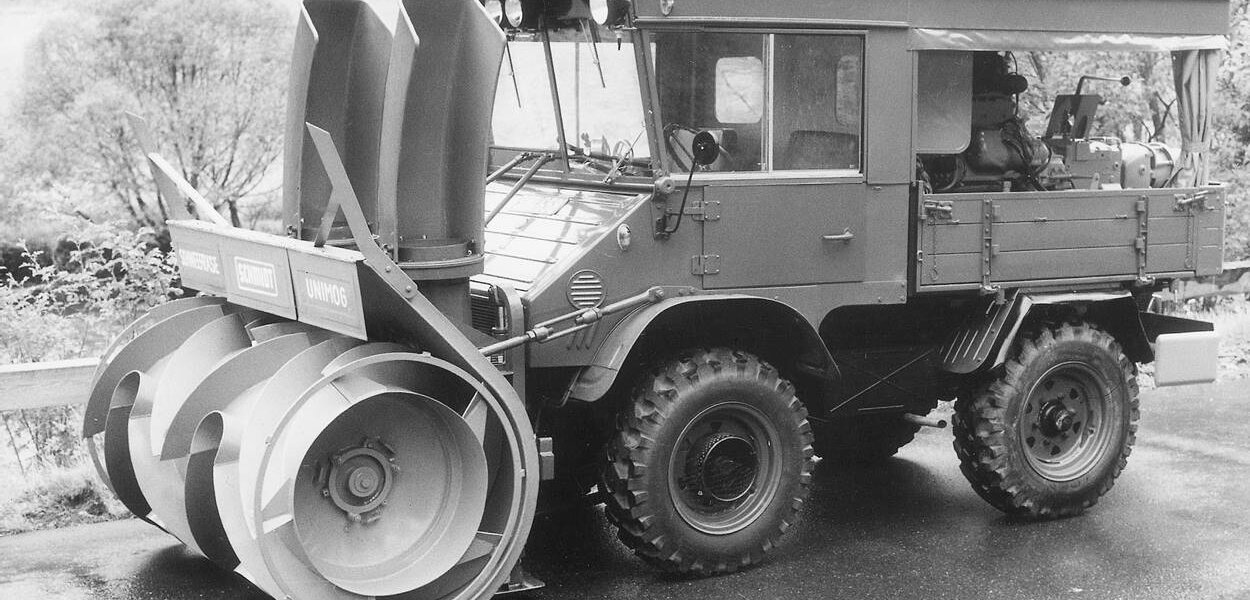The Great St. Bernhard Pass connects Valais in south-western Switzerland to the Aosta Valley in Italy. The pass also gives its name to a well-known dog breed, the St. Bernard, which has become generally known as a rescue dog and whose breeding history at the Great St. Bernard Hospice dates back to the 17th century. Even before the first road tunnel crossing the Alps through the Great St. Bernhard was opened in 1964, Alfred Schmidt junior, son of the eponymous company founder, celebrated a world premiere on the pass, which significantly influenced snow removal technology through to the present day.
The origins of the story of this world premiere lie even further back, in 1953. In that year, Alfred Schmidt launched his first VF1 snow cutter shortly after completing his engineering degree. With a drive output of 85 hp, attached to a Unimog with far less horsepower, large amounts of snow could be cleared at a speed that was revolutionary at the time. Large amounts do not necessarily mean at great depth, however, and it was this that kept Alfred Schmidt working tirelessly. It took a few years before he finally demonstrated to the public in Lech, Austria, in 1959 how his technology could also be used to cut excess. Excess depths refer to snow depths that are deeper than the cutting height. At that time, such excess depths could only be removed using hand shovels and a lot of manpower. The cutting system developed by Schmidt facilitated snow removal which, in addition to reducing effort and the risk of accident, also meant that passes could be reopened earlier. As mentioned above, the first road tunnel connection followed a year later, but passes remained the norm for many routes. Other road tunnels through the Alps such as the San Bernardino, Arlberg, Gotthard and Karawanks tunnels only followed years and decades later. Furthermore, the earlier opening of the passes was a particular blessing for the places with a tunnel connection because it partially compensated for the reduced tourism caused by the tunnel.
Alfred Schmidt’s invention has undergone continuous technological improvement since then, but it is still the basis of modern cutting technology today. To offer a simplified explanation: the cut stem is raised mechanically at a low speed so that it can be used to cut a sort of ramp, which in turn lifts the vehicle so that the snow mass can be cleared away. The snow cutter must then be reset and the process repeated until the road is fully cleared. In the years following the first demonstration, Alfred Schmidt optimised the technology – primarily the weight distribution of the snow cutter and the force distribution on the towing vehicle. The breakthrough as well as the world premiere were celebrated in 1963 on the Great St. Bernhard Pass. Even at that time, this was documented on film, which we’re delighted to share with you here:
The large snow cutters of today not only deliver up to seven times greater drive output, but also offer state-of-the-art, comfortable work spaces and impressive throwing distances of around 40 metres. In 1963, this was still inconceivable. The largest and most powerful Supra models of today are not direct successors of the VF1 since they are self-driving. However, they still share some characteristics: they were both developed for use with large amounts of snow and there is plenty of unique Black Forest ingenuity in them.
Compare them for yourself. Here is a video of the latest Supra.
Afterword
On 4 April 2020, Alfred Schmidt passed away peacefully in his sleep at his home in the Black Forest, just a few weeks after his 97th birthday. Together with his family, we mourn the loss of a person whose dedication and commitment not only significantly shaped and developed our company, but also impacted winter service technology across the world with his typical Black Forest tinkering and ingenuity. We will always honour his memory and will celebrate his accomplishments in more detail throughout our anniversary articles.
